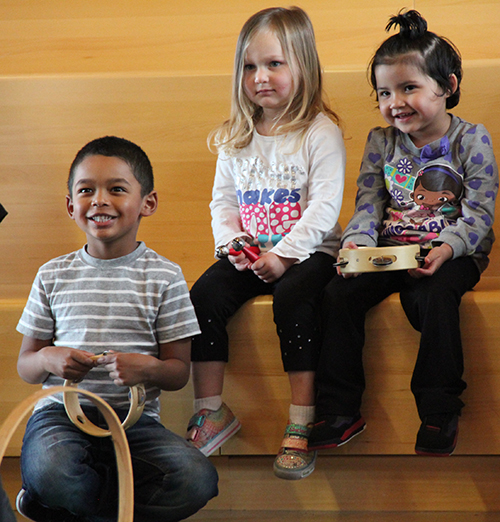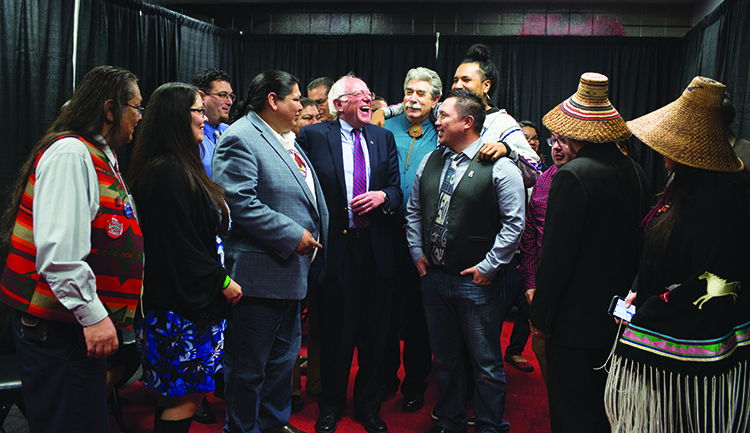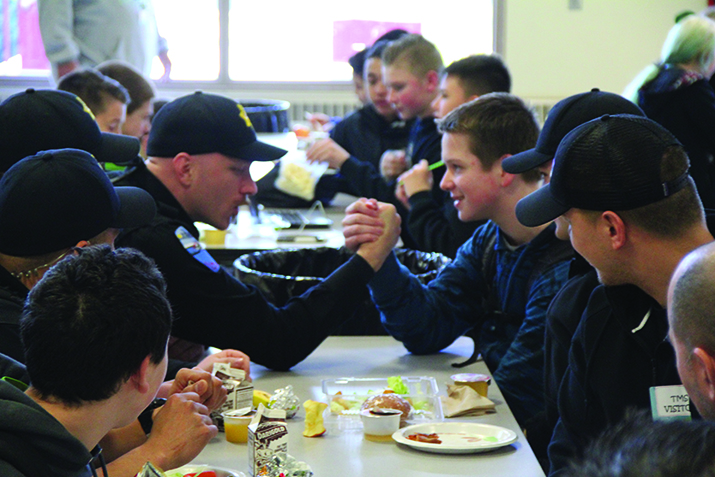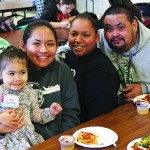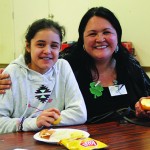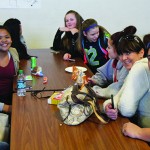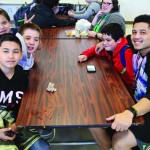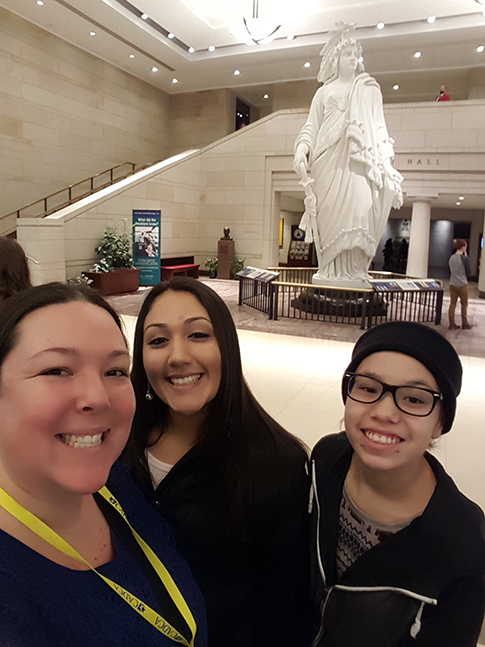Category: News
Celebrating our youngest learners

Photo/Micheal Rios, Tulalip News
Article/photos by Micheal Rios
During the week of April 11-15, the Betty J. Taylor Early Learning Academy (TELA) celebrated the Week of the Young Child. The week was devoted to shining a light on the importance of early childhood development.
“All young children need and deserve high-quality early learning experiences that will prepare them for life, and Tulalip has a great opportunity to do our part to help young children,” stated Melinda Contraro, Professional Development Manager at TELA. “Week of the Young Child is a time for Tulalip to recognize that early years are learning years for all young children.”
Week of the Young Child is an annual celebration sponsored by the National Association for the Education of Young Children. Intended to celebrate early learning, young children, their teachers and families, the weeklong event is the perfect opportunity for early childhood programs to hold activities that bring awareness to the needs of young children.
Young children and their families depend on high-quality education and care, which help children get a great start and bring lasting benefits to Tulalip. Week of the Young Child is a time to recognize the importance of early learning and early literacy, and to celebrate the teachers and policies that bring early childhood education to young children.
“We will share some activities with our families and provide take home ideas for them to do with their children,” continued Melinda. “TELA has nearly 100 early childhood professionals working together to improve professional practice and working conditions in early childhood education, and to build public support for high-quality early childhood education programs.”
The week of fun and family friendly activities kicked off on Monday, April 11, with Music Monday. The reception area was transformed into a musical platform for Alley-Oop and his sunshine band of toddlers.
Music Monday: sing, dance, celebrate and learn. Through music, children develop math, language, and literacy skills all while having fun and being active.
Taco Tuesday: healthy eating and fitness at school. This fun, food-themed day is about more than just cheese and salsa. Cooking together connects math with literacy skills, science, and more. With the rise of childhood obesity, you can encourage healthy nutrition and fitness habits in the classroom by creating your own healthy tacos.
Work Together Wednesday: work together, build together, and learn together. When children build together they explore math and science concepts and develop their social and early literacy skills. Children can use any building material – from a fort of branches on the playground to a block city in the classroom.
Artsy Thursday: think, problem solve, create. Children develop creativity, social skills and fine motor skills with open-ended art projects where they can make choices, use their imaginations, and create with their hands. On Artsy Thursday celebrate the joy and learning children experience when engaged in creative art making.
Family Friday: sharing family stories. Engaging and celebrating families is at the heart of supporting our youngest learners. We applaud family members’ role as young children’s first and most important teachers.
Annual Fishermen’s Meeting, April 21
Marysville School District provides free SAT exam to juniors on April 12
Contact: Marysville School District, www.msd25.org
Healthy Hearts, Healthy Minds
By Micheal Rios, Tulalip News
Amongst Native peoples, few things in life are as scary as diabetes. And then, after being clinically diagnosed with diabetes, a person must take many steps to resume a normal life, and in most cases, a more healthy lifestyle. What can be just as surprising as the diabetes itself are the unexpected, nonphysical effects, which are equally threatening to one’s quality of life. Although these effects might make the road to diabetes management somewhat bumpy, experts from the Healthy Hearts team from the University of Washington’s Indigenous Wellness Research Institute are demonstrating that life with diabetes not only goes on, but can get better.
The Healthy Hearts team has been working to understand and address cardiovascular disease in the Tulalip community since 2008. The first study, Healthy Hearts Across Generations, collected surveys from 284 randomly selected participants from the Tulalip tribal membership to examine cardiovascular disease risks and look at what coping strategies were most productive. From 2010 to 2012, Healthy Hearts Across Generations also provided 135 community parents and guardians with culturally influenced classes to promote health in their families.
In 2012, planning began for the second Healthy Hearts study called Healthy Hearts, Healthy Minds. This was launched in 2013 for Natives in the Tulalip area whose diabetes/prediabetes put them at greater risk for heart disease. Healthy Hearts, Healthy Minds provided those who were eligible and wanted to participate with one-on-one wellness counseling to take control of their diabetes self-care. This study came to a close in late February.
Local community resources and input from tribal members were used to develop study materials and programs, which were culturally-adapted and designed to promote sticking with positive, healthy behaviors even when it can be tough in the face of busy schedules and other challenges.
Just as exercise strengthens the mind as well as the body, awareness and education play an important role in nonphysical healing. Optimal diabetes management is more likely when people understand the nature and persistence of diabetes, and the fact that it is treatable. It’s more than just sharing facts; people also must be taught how to return to healthier lifestyles and avoid the habits that likely contributed to their health issues in the first place. This is yet another way in which wellness counselors are beneficial, providing an evidence-based intervention strategy to help participants succeed with diabetes management.
“Our focus was the wellness mental state. With diabetes, one of the challenges is that you are asked to do so many things to take care of it yourself. You have to change how you eat, you have to exercise, and check your blood sugar, you have to take your medicine, and don’t forget about getting your eyes and feet checked. It becomes very overwhelming for people,” says Rachelle McCarty, Project Manager of Healthy Hearts, Healthy Minds. “If you are really stressed out, then it’s hard to take care of yourself. That’s where our program aimed to help out. We provided participants with one-on-one coaching and very useful tools and information, so they could minimize their stress level to better manage their diabetes.”
Participants were asked to meet with a wellness coach for 10 sessions over a three-month period. Throughout the sessions, participants worked with their wellness coach to identify individual goals they wished to focus on regarding their pre-diabetes or diabetes and stress. They also worked with their coach to complete the Healthy Hearts, Healthy Minds curriculums, which covered a range of topics and skills like problem-solving, adherence, motivation and relaxation training.
Wellness coach Michelle Tiedeman, who has been with Healthy Hearts since 2009, says “What I enjoyed the most was working one-on-one with individuals and seeing them make one small, positive change at a time that added up to better overall wellness. It has been an honor to work with the Tulalip community the past several years. I have had the pleasure to work with some amazing individuals and see them accomplish great things.”
Healthy Hearts sponsored an informational lunch to share results from Healthy Hearts Across Generations in August 2014, and hosted a community celebration on February 2, 2016 to honor Tulalip’s commitment to health and share results from Healthy Hearts, Healthy Minds. You may have also seen them giving out results flyers and booklets at public events, health fairs, and the semi-annual General Council meeting last year.
Here is a sample of some of the findings:
- 42% of tribal members who responded to the health survey said they do participate in traditional activities like culture night, canoe journey, salmon ceremony, talking circles, and others.
- 40% of tribal members who responded to the health survey reported that they had high blood pressure, 50% of the men and 32% of the women.
- 27% of parents reported that they often use their own behavior as an example to encourage their child(ren) to be physically active.
- 77% shared that they have one or more blood (biological) relatives with diabetes.
- Those who enrolled in Healthy Hearts, Healthy Minds significantly lowered their depressive symptoms.
- Healthy Heart, Healthy Minds participants rated themselves significantly better at sticking with their goals at the end of the program compared to the beginning.
- 70% agreed with the statement, “I have a responsibility to walk in a good way for future generations.”
For help with your diabetes, contact the Diabetes Care and Preventions Program at 360-716-5642. For more information on the projects or results available to date, email the Healthy Hearts, Healthy Minds study at iwri@uw.edu. The projects were funded by the National Heart, Lung and Blood Institute, and the National Institute on Minority Health and Health Disparities.
Contact Micheal Rios, mrios@tulaliptribes-nsn.gov
Restorative Justice returning to Tulalip courthouse
By Niki Cleary, Tulalip News
What’s the surefire way to stop a behavior? Punish it, right? From schools, to workplaces, animal training to penitentiaries we see examples everywhere. Obviously, punishment works or we wouldn’t keep doing it. Except, in some cases, common wisdom is entirely wrong. Punishment doesn’t work, as evidenced by the number of repeat offenders in jails and prisons across the country.
First, we have to look at why people commit crime. Picture this individual: 30-something, active drug user since the eighth grade. This person began using drugs to escape from abuse that was never disclosed to the immediate family. This person has no job, is couch surfing most nights but occasionally living in a tent. This person has severe tooth decay from a combination of drug use, malnutrition and lack of dental care. Stealing and selling stolen items has become a form of income to fund a continuous supply of drugs. By the time this person is arrested and in court, the person’s family, having been lied to and stolen from when they assisted in the past, is unwilling to help the person any longer.
“The traditional Judeo Christian justice system is about stigmatization,” said Tulalip Prosecutor Brian Kilgore. “When all you have is a hammer, everything is a nail. Traditionally, you do something bad and we punish you and you don’t do it again. In most places a lot of criminality is driven by drug or alcohol addiction. At the end of the day, no one wants to be an addict and nobody wants to be a criminal. Relying on a traditional justice system is not the right way to do it and not the effective way to do it.”
The solution has been around for thousands of years in Native America, it’s called restorative justice. In a self-governance class taught through Northwest Indian College, tribal Judge Mark Pouley told a story.
“August 5th 1881, a member of the Sioux tribe named Crow Dog, shot and killed the chief of the tribe, Spotted Tail,” described Pouley. “The murder was dealt with internally by the tribe, by having Crow Dog pay $600, 8 horses and one blanket. The justification for that kind of tradition is an emphasis on healing the wound to the community and the accountability for the wrongdoing is reparation to the community, to the surviving victims, that is the more important thing, the idea of reparation and healing.”
The sentiment in the nearby non-Indian community was that requiring only restitution was the opposite of justice, that the man should be hanged to ‘punish’ him for his crime. The tribe involved, however, knew that the tribal community and Crow Dog would both be better served by reintegrating Crow Dog into the community.
Unlike many small communities, tribal citizens are uniquely tied to their geographic community. Many tribes require residency or physical proximity to a reservation to be enrolled, access services and participate in governance. This means that regardless of criminal history, tribal citizens are less likely to leave the Reservation permanently. Brian explained that true justice is served by setting people up to succeed, not just punishing them when they fail. Enter the idea of a specialty courts and alternative sentencing.
“Nationally there’s a movement across the country to provide wrap-around services to people with drug addiction,” Brian described. “Specialty courts are diversion programs that focus on specific groups of people and specific causes of crime. Veterans courts have popped up, drug courts, family courts. They all allow you to keep crimes off your record.”
Instead of receiving jail or prison time for crimes, specialty courts try to find and treat root causes of crimes. Instead looking at sentencing as a way to punish a person for being bad, the court works to heal the person so they don’t behave badly.
“Overwhelming data shows that specialty courts are effective, humane and save money,” declared Brian. “They are more intensive up front, but you have less recidivism (recidivism = the tendency of a criminal to re-offend) and people are living their lives instead of coming back through the system.”
Tulalip is currently building a Healing to Wellness Court. Recall our imaginary 30-something criminal? That person is the ideal candidate for this type of court.
“It will be a uniquely Tulalip court that gives people the support they need to be successful and get to the root causes of what drives the criminal behavior,” said Brian. “A wellness court coordinator establishes linkages with other services. Users have serious medical needs. One of the things that might bring them back to substance abuse is chronic pain, mental health, trauma or PTSD (post-traumatic stress disorder).
“The current system feels a lot like a game of whack-a-mole,” described Brian. “We fix one thing then another pops up. . If all you offer an addict is housing, then in a couple years you have drug houses. If you only offer counseling, then individuals with addictions to meth move onto opiates to treat pain because they have raw exposed nerves in their teeth from tooth decay. You have to address all the issues at the same time if you want people to change. That’s not happening in our current system.
“In a lot of ways specialty courts are less punitive and more closely supervised,” Brian continued. “We’ll have someone from Behavioral Health working with us on every case, every day. A community member will make linages with cultural and community activities. There is a drug culture and you have to reintegrate them [an addict] into non-drug culture, otherwise they’ll slip back into it [addiction]. The difference is that we’re trying to put the re-integrative part back in. We’re going to help people build bridges.”
Many may recall Tulalip’s previous efforts to provide restorative justice, including the Elders’ Panel. Those efforts heaped additional duties on already strained staff, and relied heavily on unpaid staff.
“Structurally it wasn’t very robust,” said Brian. “You had a lot of people who were volunteers, there was some staff turnover and that was the end of it. What we’re doing differently is this will be part of people’s jobs and there is also funding behind it. It’s not going to be something that can fade away. We’ll be working with more departments and gathering more metrics so we can show how we’re being successful.”
Brian estimates that 25% of the court’s current caseload would be good candidates for the Healing to Wellness program.
“At the end of the day, this is a court program for anyone who is ready to make a change in their life and wants to address the reasons they’re sitting in that orange jumper. If they’re not ready to make a change, this program is not for them.
Prosecutors often have a reputation for power tripping or being just plain mean, so it may seem strange that the Prosecutor’s Office is help spearhead a less punitive and more compassionate court system.
“Long before I was in law enforcement as a lawyer I did a ride along with a Walla Walla police officer. He said, ‘every time I have an interaction with the public, I want them to say thank you.’ He was absolutely right. Police are here to serve and protect, and so are prosecutors. People should feel they were treated fairly, not that they won, but that they were treated fairly.
“It’s a great privilege to be a prosecutor. Prosecuting someone is an intervention point. A bad prosecutor can ruin people’s lives. A good prosecutor has the power to transform the lives of people, both those that they prosecuted and those who were victims of crimes. Justice is a powerful ideal, and that’s what we’re about. A prosecutor’s job is to see justice done.”
The Tulalip Healing to Wellness Court is slated to begin January 2017. Keep your eye on the syəcəb for updates and information about the Healing to Wellness Court.
Tulalip feels the Bern
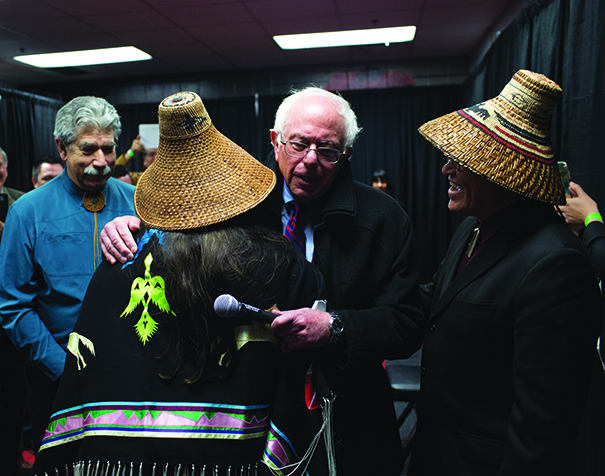
By Micheal Rios, Tulalip News; photos courtesy Nicole Willis
Native Americans are the first Americans, yet they have for far too long been treated as third class citizens. It is unconscionable that today, in 2016, Native Americans still do not always have the right to decide on important issues that affect their communities. The United States must not just honor Native American treaty rights and tribal sovereignty, it must also move away from a relationship of paternalism and control and toward one of deference and support. The United States has a duty to ensure equal opportunities and justice for all of its citizens, including the 2.5 million Native Americans that share this land. It is no secret that this isn’t the case today.*
“Time and time again, our Native American brothers and sisters have seen the federal government break solemn promises, and huge corporations put profits ahead of the sovereign rights of Native communities. As President, I will stand with Native Americans in the struggle to protect their treaty and sovereign rights, advance traditional ways of life, and improve the quality of life for Native communities,” states Democratic presidential candidate Bernie Sanders.
Sanders has repeatedly acknowledged the need to correct the U.S. history books and openly apologized for the wrongs done to Native people. It’s easy to understand why Natives from all across Indian Country are choosing to ‘feel the Bern’ and rally behind a candidate who honors us in such an honest and sincere manner.
Sanders continues to gain support and more momentum towards his bid for the White House, evident in his holding the largest political rally Seattle has seen since Obama in 2008. An estimated 18,000 people showed up at KeyArena on Sunday, March 20 to show their support for the Vermont senator.
Amongst his horde of supporters were many respected leaders and representatives of Coast Salish tribes, including Tulalip’s own Chairman Mel Sheldon and recently re-elected Board of Directors Theresa Sheldon and Bonnie Juneau.
“For the first time in my life a U.S. Presidential candidate spoke on Native American issues during his national platform. Elevating tribes to the national platform is a big deal,” says Theresa Sheldon. “It’s so important for tribes to be engaged and visible during this Presidential election. Our relationship is with the federal government, therefore we need to be present and participate in the civic process.”
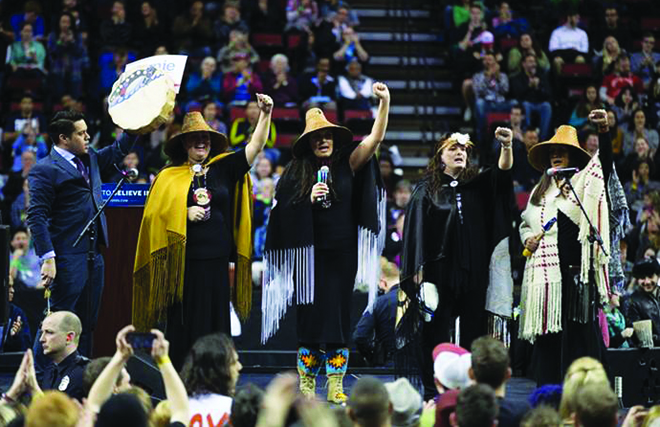
During the rally, five Tulalip tribal members (Theresa, Bonnie, Deborah Parker, Monie Ordania and Justice Napeahi) took center stage to perform the Women’s Warrior song.
“We are thankful the creator gave us an opportunity to sing the Women’s Warrior song from our First Nations relatives at the Bernie Sanders rally,” adds Theresa. “The Women’s Warrior song honors and acknowledges the missing and murdered indigenous women who have been taken from us way before their time.”
In a more private setting, Sanders met with a tribal delegation including NCAI President Brian Cladoosby, VAWA champion Deborah Parker and Yakama leaders including Asa Washines.
It was during this setting that the Coast Salish leaders honored Bernie Sanders with a Lushootseed name.
“Native American leaders named Bernie Sanders ‘δΞσηυδιϖυp’ (pronounced dooh-s-who-dee-choop),” Deborah wrote on Facebook. “This name is now bestowed upon Bernie Sanders and will be known among the Coast Salish people and beyond. The Lushootseed language meaning is ‘the one lighting the fires for change and unity.’ Thanking our Tulalip language teacher Natosha Gobin for helping us with Bernie Sanders Lushootseed name.”
According to Theresa, Sanders’ rally was historical for many reasons. Sanders has not only been a huge supporter of native issues, but he continues to stand shoulder to shoulder with tribes on such important issues as Violence Against Women and Oak Flats. He is an absolute protector of Mother Earth and he gives tribes total credit for the conservation and protection of the Earth that we do. If push comes to shove and the U.S. President has to make the call to either support treaty rights or to support corporate America and Army Corp of Engineers in the permit to build the coal terminal at Cherry Point, then you can guarantee that Sanders will go with treaty rights and support the tribes.
This is a huge shift that is happening nationally. Tribes are finally elevating themselves to the appropriate level, forcing mainstream media and corporate America to pay attention to us. When we are seen and heard by candidates, we can and will make a difference.
*source: https://berniesanders.com/issues/empower-tribal-nations/
Partners in education, building community
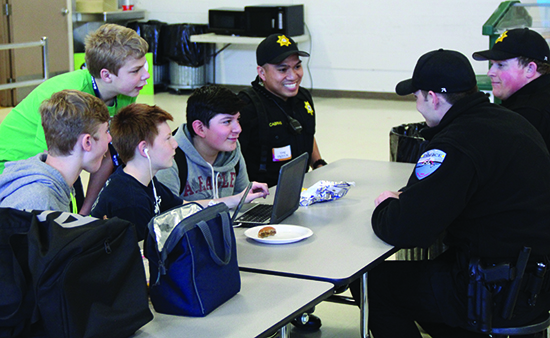
– Chrissy Dulik Dalos, Manager, Marysville School District Indian Education Department
By Micheal Rios, Tulalip News
There is a saying at Totem Middle School, PRIDE in our Learning and POWER in our Actions. Normally a saying applied to only the students and faculty, it took a much larger scale on Thursday, March 17, as it was applied to a sense of community.
During the normal scheduled 6th, 7th, and 8th grade lunch times, Totem Middle School welcomed all family and community members of Native students to enjoy a complimentary lunch while visiting with the middle-schoolers. It provided a perfect opportunity to stay connected with students, faculty, and friends while building something much larger – student success and identity safety.
“Part of identity safety is looking around the school and seeing people who look like you, knowing those around you, and feeling comfortable in a familiar setting,” says Chrissy Dulik Dalos, manager of the Indian Education Department for Marysville School District. “Our Native students go from being 80 percent of the population at Quil Ceda Tulalip Elementary to 20 percent here at Totem Middle School. We have to be vigilant that our Native students feel they are in an identity safe environment and one way of doing that is to ensure they recognize how important they are to our school’s community.”
Fostering a sense of community while also helping to bolster identity safety was particularly achieved by way of a simple open invite to have lunch. In order to get community members who Native students are comfortable with at their school and responsive to the invite, school officials went with the lunch hour. Understanding that a lot of folks are preoccupied in the late afternoon and evening hours, and not to pry into hours that may already be reserved, the time slot of 10:30 a.m. – 1:00 p.m. was chosen.
“We chose the lunch strategy to see if we could get more people involved,” continued Chrissy. “I think it paid off. We ended up with about 65 people that joined our students for lunch. That’s pretty phenomenal.”
That’s 65 Tulalip community members made up of family, friends, staff, Board of Directors, and law enforcements officers who took time out of their busy day to connect with the students. Spanning the lunch time, community members could be seen sharing a meal with the students, playing pool and foosball with them, simply chit-chatting, and even sharing in the craze that is March Madness. Students are allowed to use their Chomebooks for entertainment during their lunch. A few of the students managed to stream March Madness games and found themselves sharing their computer screens with several very attentive adults.
“For me, as an administrator, I have a strong belief that school is the center of the community, and this school has a unique location serving unique populations from Marysville and Tulalip,” explains Tarra Patrick, Principal of Totem. “So how do we create a situation where it is reconnected to the community? There is a power in breaking bread together. If you are a student here and you see your family come in and you see the principal and teachers deferring to your family, then you realize your family can come and advocate for you. This is an opportunity for the kids to also see the bridge between the school faculty, the students and their families, that’s what makes us a community.”
It really does all add up. Whether openly acknowledged or not, the Native students of Totem saw how many of their family and community members took the opportunity to spend time with them. And isn’t that what kids need the most? To feel valued by the adults around them, to know that they are important and that they matter. It’s not the sound of our words, but the POWER in our Actions that determines this.
We are all partners in education. From the teachers, secretaries, food preparers, maintenance workers, to family and friends we all have one common goal and that’s to see our students succeed. When we work together, every child can succeed in school.
Principal Tarra upholds that we all play a vital role in the success of our children and students as she stated, “It’s going to take the entire community together to support all of our students in order to help them be successful. That’s what today was about. It was just community, in this building, and it was absolutely beautiful.”
Contact Micheal Rios: trios@tulaliptribes-nsn.gov
Girls Group gains leadership experience in D.C.

By Micheal Rios,Tulalip News; photos courtesy of Sasha Smith, Tulalip Family Haven Project Coordinator
The Community Anti-Drug Coalitions of America (CADCA) held its 26th annual National Leadership Forum and Prevention Days at the Maryland Convention Center during February 1 – 4. CADCA is the national membership organization representing over 5,000 coalitions and affiliates working to make America’s community safe, healthy and drug-free.
Count Tulalip among those communities represented by CADCA, as Tulalip tribal members Elizabeth Edelman and Priscilla Bumgarner attended this year’s leadership forum. Elizabeth and Priscilla, both 15 years old, were afforded the opportunity to attend thanks to their frequent participation in Girls Group.
Girls Group, comprised of young Native women ages 14-17, is designed through Tulalip Family Haven and is located next to the Tulalip Boys & Girls Club. Girls Group aims to provide Native girls the support they need to become the most successful person they can be.
“In selecting the two young ladies to take to the prevention conference and tour Washington, D.C., we based the decision off of overall participation and best attendance at Girls Group,” says Sasha Smith, Project Coordinator at Family Haven, who chaperoned Elizabeth and Priscilla on their trip. “These girls were so excited to get the chance to travel. Elizabeth had never been on an airplane before and neither had ever been so far from home without their parents”
The young ladies spent four days in Maryland and Washington, D.C. learning about reducing drug and alcohol use in their community, how to be a positive and supporting leader, and gaining life experiences on the other side of the country. They received helpful information about different groups and communities who have been successful in reducing substance abuse.
“Better environment, better future,” recalls Elizabeth is the line that really stood out from the seminars she attended. “It’s so true. If nobody cared about their surroundings and the environment then things can’t get better, they’ll only get worse. If you care about your future then you’ll care about your environment, who and what you have around you.”
A project they got to participate in, and may even do here at home, was a sticker project. The youth, armed with message carrying stickers, went around to local liquor stores and convenient stores placing stickers on alcohol products, as a way to remind buyers that underage drinking and purchasing for minor is illegal.
Another idea they participated in was being part of a high school student panel dubbed the Myth Busters. They held a Q & A session for middle school students who are in transition to high school. The middle schoolers were able to ask any and all questions they had about the high school experience, most of which were debunked as myths by the current high schoolers.
Of all their experiences during the four days away from home, the most lasting was getting a guided tour of the capital, which included taking a three hour night tour of all the historical monuments.

“The entire experience was pretty cool. Being out of here and off the rez everything was new, it felt like a vacation,” said Elizabeth. “Touring the capital and seeing the Lincoln Memorial was most memorable for me. And learning about Billy Frank, Jr. He has his own exhibit in the Museum [of the American Indian].”
Girls Group meets every Monday, Tuesday, Wednesday and Thursday from 3:30p.m. – 6:30p.m. and is free to join. For more information on the Family Haven Girls Group or how to sign up, please contact project coordinator Sasha Smith at 360-716-4404.
Tulalip students are in need of Natural Leaders
By Micheal Rios, Tulalip News
“When the schools and families have a mutual respect for one another and depend on one another as partners in education, the result is increased achievement.” That is a key line from Dr. Steve Constantino’s 101 Ways to Create Real Family Engagement. For Tulalip, getting parents and families engaged in their students’ academic well-being remains a lofty goal. Local schools and many tribal service departments have proclaimed their strategies for family engagement and getting families vested in our students’ academic success, but most fall short of their proclamations.
In order to change this, we must help to build a new cultural foundation and create relationships that motivate family involvement and ultimately create family engagement. Research has constantly shown students’ success to be highly correlated with the level of their parent engagement. When parents are involved, students achieve more, regardless of socio-economic status, ethnic/racial background, or the parents’ education level.
Hoping to spark the must needed change for the sake of our students, Tulalip tribal member Eliza Davis, who works as a Native Liaison for the Marysville School District, is creating a parent engagement project that piggybacks off the Natural Leaders initiative. It is Eliza’s mission to help all our children succeed in school by providing skill building opportunities and in-class volunteer hours for parents to help their kids succeed.
“It is my dream that we will see a group of families and community members emerge and begin taking on leadership roles within the school. We want to help build the families capacity to be partners in their student’s education. That is the piece we are missing here at Quil Ceda Tulalip Elementary, the family and community representation in our work,” explains Eliza. “We are striving to integrate families in all levels of the work we are doing through the Natural Leaders initiative. We need to get input on our school improvement plan. We want to get parent involvement in building our leadership team. Really, we are just seeking parents to be in the building as volunteers, to help us bring more community events throughout the year, and eventually to bring some fundraising to events for our school.”
The Tulalip Natural Leader project challenges parents to take on a leadership role. They will build relationships with families in the community, identify what helps these families be successful with education and then implement these ideas. A driving focus is collaborative community organizing where parents are equal partners sharing a common goal of children achieving success in education.
“We are starting this work at Quil Ceda Tulalip Elementary, but really I am thinking how we could be building this type of work up with our families in all our schools; the Betty J. Taylor Early Learning Academy, Totem Middle School, and the three high schools our kids are attending (Heritage, Marysville Pilchuck and Marysville Getchell),” continues Eliza. “We believe that family and community engagement work will bring great success for our Tulalip students. The research proves that these strategies are effective in bridging the opportunity gap in schools. We hope to be working side by side with more families and community members through this initiative very soon.”
According to the Washington Alliance for Better Schools, Natural Leaders are warm, caring social persons who serve as multicultural bridges between students, teachers, communities and schools. In our community we hear so much about education, the need for a cultural presence in our school, and advocating for our youth, especially around General Council season. Here is the perfect opportunity to show your support for our youth, our educators and our community by becoming a part of the Natural Leaders initiative.
Lack of parental supervision or a plain absence of parental engagement in their children’s day to day life is the most harmful demographic trend of this Native generation. It is the leading cause of declining child well-being in our society. It is also the engine driving our most urgent social problems, from crime to adolescent pregnancy to substance abuse to perpetuating the impoverish mindset that clutches so many like a mental vice grip.
It is very powerful when adults engage in education themselves because actions speak louder than words. Children view adults as role models and aspire to be like them. Parents and Tulalip community members who answer the call to become Natural Leaders will experience personal growth that comes with giving of oneself for the better of our younger generation. Personal growth and transformation is an important outcome that leads to stronger communities and academic success for children.
“Parent and community engagement is an integral part of a successful school. In order to achieve academic success, parents and staff members need a strong partnership,” states Cory Taylor, Quil Ceda Tulalip Elementary Principal. “Thankfully the Natural Leaders program is designed to accomplish this objective. One particular way the Natural Leaders program has benefited our school is through the volunteer program. Parents have assisted in the following areas: after school events, classroom projects, perfect attendance awards, maintaining the school calendar, and individual academic student support.
“We are looking forward to building on the Natural Leaders program in the upcoming months and years. As we strengthen staff and parent relationships through this program we will be creating a brighter future for our students and children.”
Whether you are a parent, grandparent, uncle, aunt, or concerned community member, please consider becoming a part of Tulalip’s Natural Leader initiative. The next Natural Leaders group meeting will be Wednesday, March 23, at noon in room 162 of the Tulalip Administration building.
Share what the mission of the Natural Leaders group is and help our community to recruit able and willing employees, community members, parents and guardians. Become a part of the movement, be the ripple effect and support our youth.




